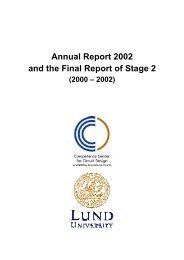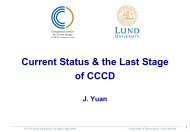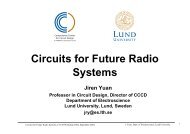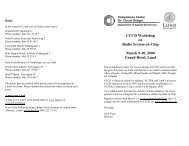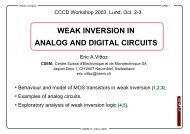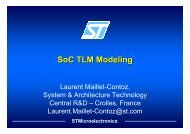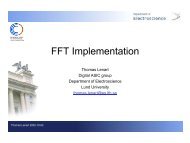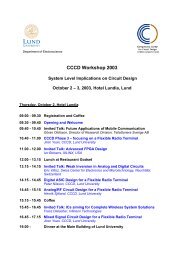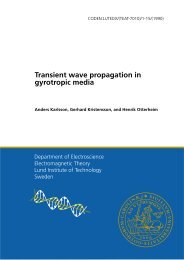Design of Antennas for Handheld DVB-H ... - Lunds tekniska högskola
Design of Antennas for Handheld DVB-H ... - Lunds tekniska högskola
Design of Antennas for Handheld DVB-H ... - Lunds tekniska högskola
Create successful ePaper yourself
Turn your PDF publications into a flip-book with our unique Google optimized e-Paper software.
2.1.3 Reed-Solomon Codes<br />
2.1.4 <strong>DVB</strong>-T<br />
Reed-Solomon codes (RS codes) are block-based error correcting codes and are<br />
very widely used in digital communications and storage. RS codes can detect and<br />
correct errors within blocks <strong>of</strong> data and are used in a lot <strong>of</strong> applications, <strong>for</strong><br />
example:<br />
• Storage devices (including tape, compact, DVD, barcodes, etc)<br />
• Wireless or mobile communications (including cellular telephones,<br />
microwave links, etc)<br />
• Satellite communications<br />
• Digital television / <strong>DVB</strong><br />
• High-speed modems such as ADSL, xDSL,etc<br />
The RS encoder takes a block <strong>of</strong> digital data and adds extra "redundant" bits.<br />
Errors occur during transmission or storage <strong>for</strong> a number <strong>of</strong> reasons (<strong>for</strong> example<br />
noise or interference, scratches on a CD, etc). The Reed-Solomon decoder<br />
processes each block and attempts to correct errors and recover the original data.<br />
<strong>DVB</strong>-H uses RS (255,191), were 191 is the number <strong>of</strong> in<strong>for</strong>mation symbols input<br />
per block and 255 the number <strong>of</strong> symbols per block that the encoder outputs, the<br />
code rate can be varied. The term symbol may represent one bit or a number <strong>of</strong><br />
bits. The number and type <strong>of</strong> errors that can be corrected depends on the<br />
characteristics <strong>of</strong> the Reed-Solomon code and is always half <strong>of</strong> the parity<br />
symbols. So in the <strong>DVB</strong>-H system it is possible to correct up to 32 errors in a<br />
codeword [9].<br />
<strong>DVB</strong>-T is the terrestrial mode <strong>for</strong> Digital Video Broadcasting. <strong>DVB</strong>-T has been<br />
selected as the common standard <strong>for</strong> digital television in Europe and is the base<br />
plat<strong>for</strong>m <strong>for</strong> <strong>DVB</strong>-H, witch makes it possible to transmit IP-packages to handheld<br />
terminals. The standard <strong>for</strong> <strong>DVB</strong>-T was adopted in December 1995. In November<br />
1998 the first <strong>DVB</strong>-T network became operational in the United Kingdom. Since<br />
1998 <strong>DVB</strong>-T has been introduced in Europe, Australia, Singapore and Taiwan [6].<br />
See figure 2.2 to see the spread <strong>of</strong> the different digital TV specifications.<br />
In <strong>DVB</strong>-T, each program is sent over a separate logical channel that is identified<br />
by a unique packet identifier. All users that have access to a specific service may<br />
receive any program on that logical channel. The control streams used with the<br />
packet identifiers such as the program and service in<strong>for</strong>mation are transmitted<br />
repeatedly from the head end to the users [10].<br />
7



